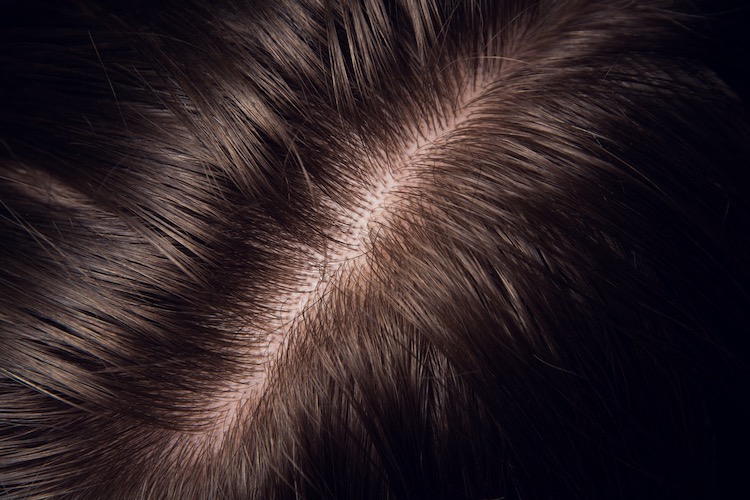5 Tips for a Healthier Scalp & Improved Hair Growth

Addressing hair loss means getting to the root of the problem. And, quite literally, that means taking care of your scalp. A healthy scalp means better hair growth results and it’s a key component to preventing future hair loss. To help you get started, our hair growth experts share insider information on what happens when we neglect our roots and their top 5 tips for a healthy scalp.
What’s at the Root?
It’s not just about your strands, but what’s inside each hair follicle that can impact hair loss or keep hair growing. Your hair follicles keep strands in place, add natural moisture to your hair, and grow strands. For hair to remain anchored and thriving, the follicle needs to be clean, unclogged, and nourished with the proper nutrients. (01)
Your Scalp is Alive, Your Hair…Not So Much
Your hair alone isn’t a live organism but a strand of dead cells. That said, all the factors that keep hair growing depend on living cells. As the hair begins to grow, it nudges itself up from the base of the follicle and through the uppermost levels of the scalp. Small blood vessels feed the cells in each follicle, providing nutrients to keep your hair growing. (02)
Almost every hair follicle is attached to a sebaceous gland, also known as an oil gland. These oil glands secrete a substance called sebum which coats and moisturizes the skin and keeps hair shiny and healthy. A hair follicle blocked by excess sebum, dandruff, or dead skin can’t grow or hold hair effectively. (02)
5 Healthy Scalp Tips
According to the American Academy of Dermatology, taking care of your scalp can boost the health of your hair and, perhaps, even improve your self-confidence. The following are five tips for a healthier scalp and hair. (03)
1. Protect Your Scalp from the Sun
Although you diligently use sun protection and SPF on your body and face, you may forget about your scalp. Thinning hair or bald spots leave the scalp vulnerable to the sun’s UV rays. Also, even a head full of thick hair can still need shielding from the sun. Where your hair parts or the crown of your head needs extra attention because these areas can sunburn in direct sunlight.
To protect your scalp from the sun, apply sunscreen onto the exposed areas on your scalp whenever you’re outside for prolonged periods. The following are a few sunscreen options for your scalp: (04)
- Avoid standard sunscreens used for the body because they make hair oily.
- A stick sunscreen works for small areas (like the crown or part).
- Powder sunscreen options are excellent for both bare and covered scalp areas but can be pricey.
- Sunscreens with a spray or mist are a cost-effective choice but can weigh hair down.
One practical method to protect your scalp is by wearing a hat or some other type of head covering to block the damaging rays of the sun.
2. Wash Your Hair Regularly
Maintaining a clean scalp is a critical way to keep your scalp and hair healthy. Unwashed hair can lead to oil, dirt, and cell buildup, which blocks hair follicles. However, over-washing your hair can also lead to problems like dryness and flaking. To determine how frequently to wash your hair, you must figure out your hair type. (03)
Oily hair needs almost daily washing. Dry hair, however, may require twice or once a week washing, depending on the environment and your activity level. For example, people with dry hair who live in humid areas and exercise often may need to wash their hair more frequently than someone with the same hair type who lives in a dry, cool climate and doesn’t sweat.
3. Choose Your Shampoo Wisely
It’s tempting to purchase whatever shampoo is on sale at the drugstore, but the ingredients in the shampoo matter. For instance, many shampoos have sulfates to create a thick “lather,” which leads people to believe their hair is getting “clean.” Sulfates create bubbles for lather, but bubbles aren’t what clean your skin, hair, or scalp.
Unfortunately, the addition of sulfates can strip beneficial oils from the hair. People with sensitive skin may develop skin irritations from sulfate shampoos. Using sulfates can result in dull, dry, and brittle hair — which then lead to heart loss or thinning.
You can boost hair growth, however, through quality ingredients. Some ingredients that may improve scalp health: (04)
- Peppermint oil
- Tea tree oil
- Vitamin E oil
- Rosemary leaf extract
Finding quality ingredients will help you find the right shampoo to clean your hair without stripping it of healthy oils.
4. Eat a Healthy Diet
Your scalp needs specific nutrients. Oxidative stress, damage to the body caused by free radicals, can cause hair loss. A nutritious diet filled with fresh produce and low on processed foods can counter oxidative stress through antioxidant consumption. (05, 06)
Found in nuts, fruits, and vegetables, antioxidants fight oxidative stress. The following are some examples of antioxidant-rich food sources: (05, 06)
- Kale
- Strawberries
- Artichokes
- Spinach
- Blueberries
- Beans
- Red Cabbage
Another nutrient that may help to thicken hair and keep the scalp healthy are omega-3 fatty acids. Found in fatty fish, nuts, and plant oils, omega-3 strengthens cells throughout the scalp by stimulating circulation. Additionally, omega-3 reduces inflammation and makes the scalp less reactive to irritants. (07)
5. Treat Your Scalp to a Massage
Massaging your scalp can result in thicker and healthier hair. According to a small 2016 study, men who received a daily 5-minute scalp massage for 24 weeks ended up with thicker hair at the end of the study compared to the beginning. Gentle scalp massage may promote hair growth in cases of thinning hair or hair loss, like alopecia.
A scalp massage stimulates hair follicles and encourages blood flow through the area. Improved blood flow delivers nutrients to hair follicles and fortifies follicles. Regular scalp massages are easy to do yourself, using your fingertips or a massage tool. Be sure to use a gentle touch and avoid tugging your hair. (07)
Following the five tips above can help to keep your hair strong by giving you a healthy scalp. Your scalp is where your hair starts, so it should receive the same amount of attention you give your hair.
What Unhealthy Scalp Looks Like
Most people don’t inspect their scalp closely, but maybe they should! Spotting signs of an unhealthy scalp can alert you to possible sources of hair loss. By addressing problems before they grow, you can slow or prevent hair loss.
- Itching: Itching on the scalp can be a sign of an unhealthy scalp condition. Itching often occurs because of skin dryness on the scalp caused by an irritant, like a harsh soap, shampoo, or hair product. If the itching involves large areas or remains for long periods, it’s best to see a doctor to rule out dermatitis or psoriasis.
- Redness: Red areas on your scalp may indicate inflammation. These inflamed areas can occur as a response to an irritant or as a response to an infection. Eczema, scalp ringworm (tinea capitis), and psoriasis are some common causes of redness on the scalp.
- Pain or Burning Sensations: Pain or burning sensations are rarely a good sign, and your scalp is no exception. If your scalp feels like it’s on fire or is painful to touch, it’s likely a sign of infection that needs medical intervention.
Getting to the Root of It All
There’s more to hair than the strand of the hair itself. Keeping hair on your head starts from your hair’s foundation — your scalp. Furthermore, if you’re considering a hair loss treatment, a healthy scalp is a must. Topical treatments work best when your scalp is in good condition.
Happy Head individualizes every hair solution, ensuring the appropriate amount of medication for your situation. With a six-month money–back guarantee, we’re confident you’ll be satisfied with your results and if you have any questions your dermatologist can help. All you have to do is take our quick, 5-question quiz here to get started.
Resources:
(01) https://www.ncbi.nlm.nih.gov/pmc/articles/PMC6369642/
(02) https://www.webmd.com/skin-problems-and-treatments/hair-loss/science-hair
(03) https://www.aad.org/public/everyday-care/hair-scalp-care/scalp
(04) https://pubmed.ncbi.nlm.nih.gov/26278532/
(05) https://www.ncbi.nlm.nih.gov/pmc/articles/PMC5315033/
(06) http://Peppermint oil (04) Tea tree oil Vitamin E oil Rosemary leaf extract (05)
(07) https://www.ncbi.nlm.nih.gov/pmc/articles/PMC4740347/#__ffn_sectitle



